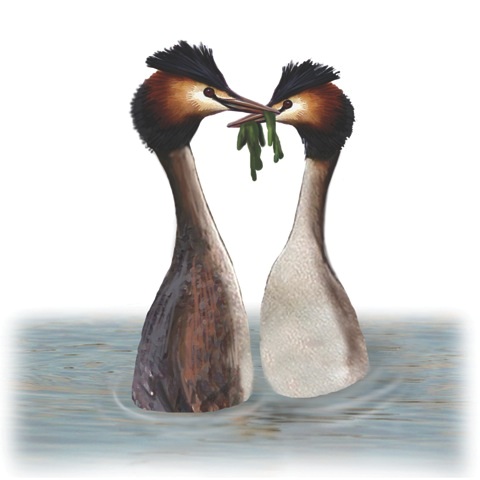
Those goodbye hugs at the train station or quick kisses in the park may have deep evolutionary roots. Such public displays of affection may help pair-bonded couples invest more in their children, boosting the offspring's survival odds, new research suggests.
The study, published today (Feb. 19) in the journal Proceedings of the Royal Society B, finds that when monogamous animals such as birds continue their displays after mating, they put more energy into parenting and can have more children than when they drop the displays.
Lifelong mates
Birds and other animals use showy feathers or elaborate courtship behaviors such as mating dances to lure potential partners.
But in the early 1900s, biologist Julian Huxley noticed that birds known as Great Crested grebes rise up out of the water like synchronized swimmers with weeds in their beaks. They continued this elaborate mating ritual, which Huxley likened to humans holding hands or kissing, even after mating.
That begged the question: Why would monogamous animals have evolved to continue these display once they'd paired up? [Top 10 Swingers of the Animal Kingdom]
"It's very obvious why you'd want a display to attract a mate, but once you've already secured a mate, why should you bother to keep displaying?" said study author Maria Servedio, an evolutionary biologist at the University of North Carolina, Chapel Hill.
Get the world’s most fascinating discoveries delivered straight to your inbox.
After all, bright colors and public displays of affection are energetically costly and make animals more visible to predators. The evolutionary benefits have to outweigh the costs for animals or they wouldn't bother.
Helping the kids
To find out, Servedio and her colleagues looked at existing studies from the animal kingdom. They noted that in monogamous species, paired-up animals are better at raising more offspring. In other words, two individual birds may be able to raise one chick at a time, but a couple can raise more than two chicks together.
The researchers also found that, in other studies, when researchers covered up mating displays like a bright red spot on a bird's bill, the animals' partners invested less in offspring, Servedio told LiveScience. Emphasizing an animal's display also seemed to increase its investment in offspring.
Researchers then used a mathematical model to see if those two effects could make displays that continue through a pair-bonded relationship evolutionarily beneficial. The scientists found that this was in fact true, because the displays made couples more likely to invest in their offspring, increasing their reproductive fitness.
Human effect?
The findings suggest that monogamous animals like humans snuggle, sport flashy feathers or canoodle on the subway because it increases parents' investment in young, and thus, increases the odds of these children surviving.
"This study points out a fascinating potential for these mutual displays to be adaptive in terms of gains in parental investment by both sexes," Rebecca Safran, an evolutionary biologist at the University of Colorado, Boulder, who was not involved in the study, wrote in an email.
While its implications are most obvious for birds, "it is not such a long stretch to imagine this process at work in human populations. The trick is that the signals used by humans to stimulate additional parental care would likely differ by culture and social context," Safran said.
Follow LiveScience on Twitter @livescience. We're also on Facebook & Google+.

Tia is the editor-in-chief (premium) and was formerly managing editor and senior writer for Live Science. Her work has appeared in Scientific American, Wired.com, Science News and other outlets. She holds a master's degree in bioengineering from the University of Washington, a graduate certificate in science writing from UC Santa Cruz and a bachelor's degree in mechanical engineering from the University of Texas at Austin. Tia was part of a team at the Milwaukee Journal Sentinel that published the Empty Cradles series on preterm births, which won multiple awards, including the 2012 Casey Medal for Meritorious Journalism.


